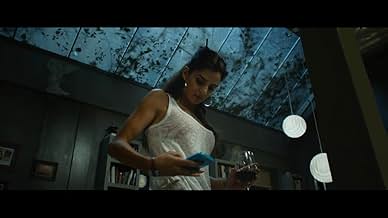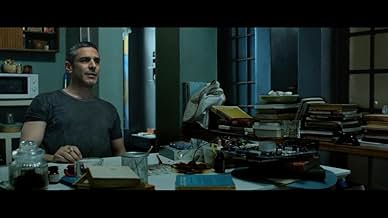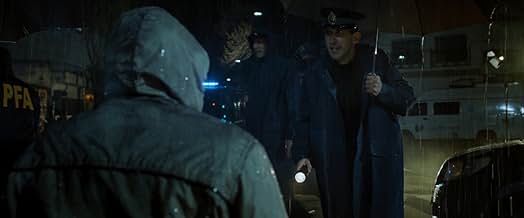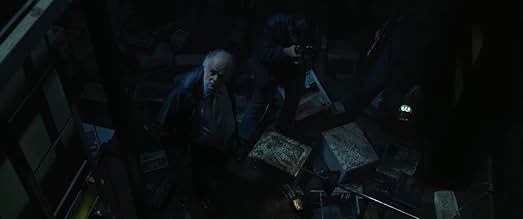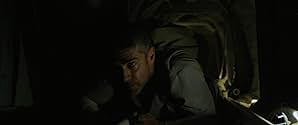PUNTUACIÓN EN IMDb
7,0/10
16 mil
TU PUNTUACIÓN
Un parapléjico ingeniero informático en silla de ruedas comienza a escuchar ruidos y voces de ladrones de bancos en su sótano.Un parapléjico ingeniero informático en silla de ruedas comienza a escuchar ruidos y voces de ladrones de bancos en su sótano.Un parapléjico ingeniero informático en silla de ruedas comienza a escuchar ruidos y voces de ladrones de bancos en su sótano.
- Dirección
- Guión
- Reparto principal
- Premios
- 4 premios y 5 nominaciones en total
Facundo Giménez
- Schwarzenegger
- (as Facundo Nahuel Giménez)
Ariel Núñez Di Croce
- Muñeco
- (as Ariel Núñez)
Cristóbal Pinto
- Pichi
- (as Cristobal Pinto)
Daniel Comini
- Cervantes
- (as Daniel Morales Comini)
Sergio Santana
- Policía 2
- (as Sergio López Santana)
Reseñas destacadas
I have never seen a heist movie with this kind of plot twists. This is unguessable as well as trickily executed. One most indulging factor is the protagonist is cripple yet how he protect himself along with the bank money is amazing.
At the End of the Tunnel proves that the most compelling heist films aren't always about the criminals pulling the job, but about the ordinary person caught in their crosshairs. This Argentine-Spanish thriller from director Rodrigo Grande transforms a simple premise into a gripping exercise in mounting tension, where every creak of the floorboards carries weight and every glance through a basement window feels loaded with danger.
Joaquín is a wheelchair-bound computer engineer threatened with foreclosure, haunted by memories of his wife and daughter who died in an accident years ago. Leonardo Sbaraglia inhabits this role with remarkable restraint, never playing for sympathy but instead crafting a fully realized character whose physical limitations become tactical advantages. His performance anchors the film's emotional core, particularly in his scenes with Spanish actress Clara Lago, who plays Berta, the exotic dancer renting a room in his crumbling house with her mysteriously silent daughter Betty.
The genius of Grande's direction lies in how he uses the confined space of Joaquín's basement workshop to create an atmosphere of voyeuristic dread. When Joaquín discovers that criminals are digging a tunnel under his house to rob the bank next door, the film shifts into thriller territory without abandoning its character-driven foundation. The camera work emphasizes the claustrophobic nature of Joaquín's world while simultaneously opening up moments of surprising intimacy between the unlikely housemates.
Pablo Echarri delivers a masterful performance as the villain, bringing a chilling matter-of-factness to his criminal mastermind that makes him far more unsettling than any scenery-chewing antagonist. The supporting cast, including veteran Federico Luppi as a corrupt police inspector, creates a lived-in world where everyone carries secrets and motivations run deeper than surface appearances suggest.
What elevates this film beyond standard thriller mechanics is its commitment to exploring themes of isolation, second chances, and the lengths people go to protect those they love. The revelation that Berta is connected to the criminal operation doesn't feel like a cheap plot twist but rather an organic development that deepens both characters' emotional stakes. The film earns its moments of violence and tension through careful character development, making every confrontation feel personal rather than perfunctory.
Grande demonstrates impressive control over pacing, allowing quiet character moments to breathe while ratcheting up suspense through sound design and strategic reveals. The basement setting becomes almost a character itself, with its maze of electronic equipment and hidden vantage points creating opportunities for both surveillance and surprise. The film's visual language emphasizes horizontal movement and hidden perspectives, reinforcing themes about seeing and being seen, knowing and being known.
While the film occasionally leans into familiar thriller territory, particularly in its final act, the strength of the performances and the genuine emotional investment in these characters keeps it compelling throughout. Grande's enjoyable caper film ratchets up tension even as it folds in smile-inducing plot twists. This isn't a film that revolutionizes the heist genre, but it executes its premise with enough intelligence and heart to make it genuinely engaging.
The film succeeds because it understands that the best thrillers aren't just about external dangers but internal transformations. Joaquín's journey from isolated recluse to reluctant hero feels earned, and the relationships he forms feel authentic rather than manufactured for plot convenience. In an era of increasingly elaborate heist films, "At the End of the Tunnel" reminds us that sometimes the most effective approach is simply to dig deeper into character and let tension build naturally from genuine human stakes.
Joaquín is a wheelchair-bound computer engineer threatened with foreclosure, haunted by memories of his wife and daughter who died in an accident years ago. Leonardo Sbaraglia inhabits this role with remarkable restraint, never playing for sympathy but instead crafting a fully realized character whose physical limitations become tactical advantages. His performance anchors the film's emotional core, particularly in his scenes with Spanish actress Clara Lago, who plays Berta, the exotic dancer renting a room in his crumbling house with her mysteriously silent daughter Betty.
The genius of Grande's direction lies in how he uses the confined space of Joaquín's basement workshop to create an atmosphere of voyeuristic dread. When Joaquín discovers that criminals are digging a tunnel under his house to rob the bank next door, the film shifts into thriller territory without abandoning its character-driven foundation. The camera work emphasizes the claustrophobic nature of Joaquín's world while simultaneously opening up moments of surprising intimacy between the unlikely housemates.
Pablo Echarri delivers a masterful performance as the villain, bringing a chilling matter-of-factness to his criminal mastermind that makes him far more unsettling than any scenery-chewing antagonist. The supporting cast, including veteran Federico Luppi as a corrupt police inspector, creates a lived-in world where everyone carries secrets and motivations run deeper than surface appearances suggest.
What elevates this film beyond standard thriller mechanics is its commitment to exploring themes of isolation, second chances, and the lengths people go to protect those they love. The revelation that Berta is connected to the criminal operation doesn't feel like a cheap plot twist but rather an organic development that deepens both characters' emotional stakes. The film earns its moments of violence and tension through careful character development, making every confrontation feel personal rather than perfunctory.
Grande demonstrates impressive control over pacing, allowing quiet character moments to breathe while ratcheting up suspense through sound design and strategic reveals. The basement setting becomes almost a character itself, with its maze of electronic equipment and hidden vantage points creating opportunities for both surveillance and surprise. The film's visual language emphasizes horizontal movement and hidden perspectives, reinforcing themes about seeing and being seen, knowing and being known.
While the film occasionally leans into familiar thriller territory, particularly in its final act, the strength of the performances and the genuine emotional investment in these characters keeps it compelling throughout. Grande's enjoyable caper film ratchets up tension even as it folds in smile-inducing plot twists. This isn't a film that revolutionizes the heist genre, but it executes its premise with enough intelligence and heart to make it genuinely engaging.
The film succeeds because it understands that the best thrillers aren't just about external dangers but internal transformations. Joaquín's journey from isolated recluse to reluctant hero feels earned, and the relationships he forms feel authentic rather than manufactured for plot convenience. In an era of increasingly elaborate heist films, "At the End of the Tunnel" reminds us that sometimes the most effective approach is simply to dig deeper into character and let tension build naturally from genuine human stakes.
My opinion-.
"At the end of the tunnel" is a movie by Rodrigo Grande and a thriller policeman realized with a small budget, but with far greater effects than some great productions, everything is there, a super scenario and a plot that takes you more and more That one advances in this movie. If you like good suspense, look at it, it is worth it.
"At the end of the tunnel" is a movie by Rodrigo Grande and a thriller policeman realized with a small budget, but with far greater effects than some great productions, everything is there, a super scenario and a plot that takes you more and more That one advances in this movie. If you like good suspense, look at it, it is worth it.
¿Sabías que...?
- CuriosidadesJoaquin has a statue very similar to the Maltese Falcon. One of the characters, Gutman, may very well be named after Kasper Gutman from the film The Maltese Falcon (1941).
- PifiasWhen Guttman hit the red pick up at the end of the movie, a first scene showed the pick-up was moving. However, the scene from inside the car right before he hit the pick-up shows that the pick-up is stand still.
Selecciones populares
Inicia sesión para calificar y añadir a tu lista para recibir recomendaciones personalizadas
- How long is At the End of the Tunnel?Con tecnología de Alexa
Detalles
- Fecha de lanzamiento
- Países de origen
- Idioma
- Títulos en diferentes países
- At the End of the Tunnel
- Localizaciones del rodaje
- Empresas productoras
- Ver más compañías en los créditos en IMDbPro
Taquilla
- Presupuesto
- 2.000.000 € (estimación)
- Recaudación en todo el mundo
- 3.190.219 US$
- Duración
- 2h(120 min)
- Color
- Mezcla de sonido
- Relación de aspecto
- 2.35 : 1
Contribuir a esta página
Sugerir un cambio o añadir el contenido que falta

![Ver Tráiler [OV]](https://m.media-amazon.com/images/M/MV5BMzU1OTIxZmItNjAzNC00NzNhLWIyZmQtZWZmMTJiMjU2ZDk0XkEyXkFqcGdeQXRodW1ibmFpbC1pbml0aWFsaXplcg@@._V1_QL75_UX500_CR0)


